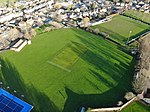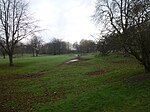Bourne Abbey
1138 establishments in England1536 disestablishments in EnglandArrouaisiansAugustinian monasteries in EnglandBourne, Lincolnshire ... and 8 more
Christian monasteries established in the 12th centuryChurch of England church buildings in LincolnshireGrade I listed churches in LincolnshireGrade I listed monasteriesHistory of LincolnshireMonasteries dissolved under the English ReformationMonasteries in LincolnshireReligious organizations established in the 1130s

Bourne Abbey and the Parish Church of St. Peter and St. Paul is a scheduled Grade I church in Bourne, Lincolnshire, England. The building remains in parochial use, despite the 16th-century Dissolution, as the nave was used by the parish, probably from the time of the foundation of the abbey in 1138.
Excerpt from the Wikipedia article Bourne Abbey (License: CC BY-SA 3.0, Authors, Images).Bourne Abbey
Church Walk, South Kesteven Bourne
Geographical coordinates (GPS) Address External links Nearby Places Show on map
Geographical coordinates (GPS)
| Latitude | Longitude |
|---|---|
| N 52.7663 ° | E -0.3756 ° |
Address
Bourne Abbey
Church Walk
PE10 9UQ South Kesteven, Bourne
England, United Kingdom
Open on Google Maps









